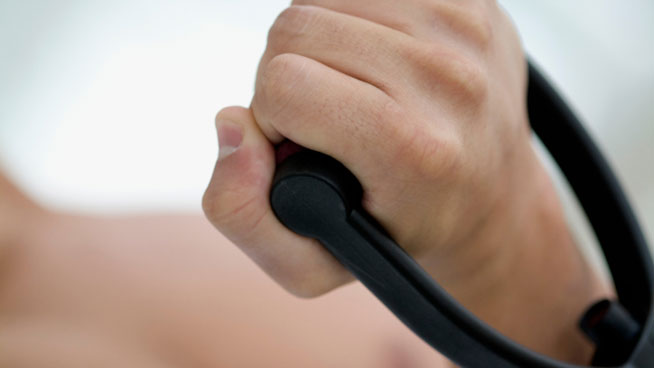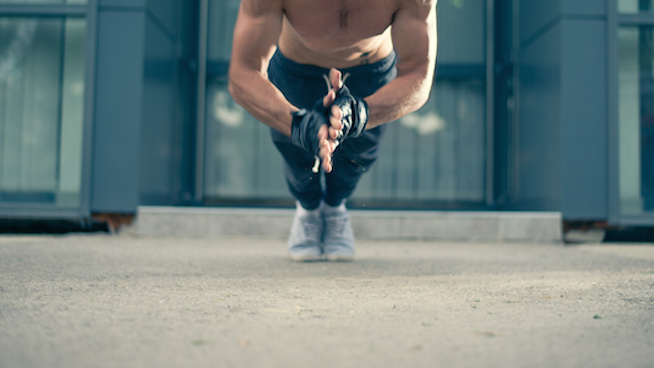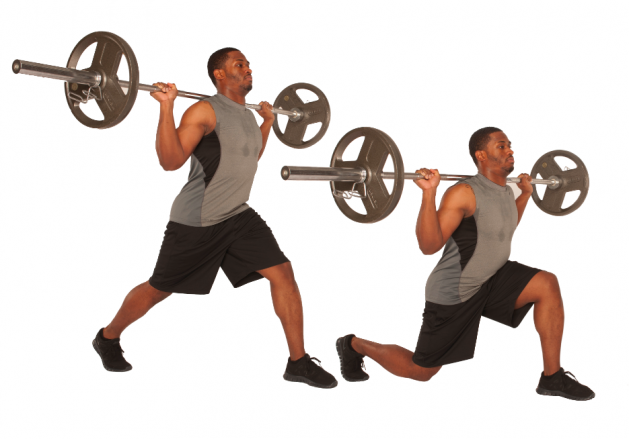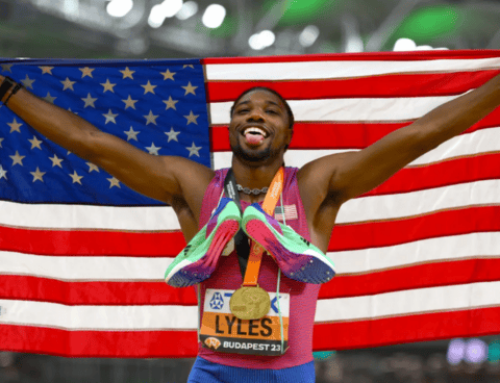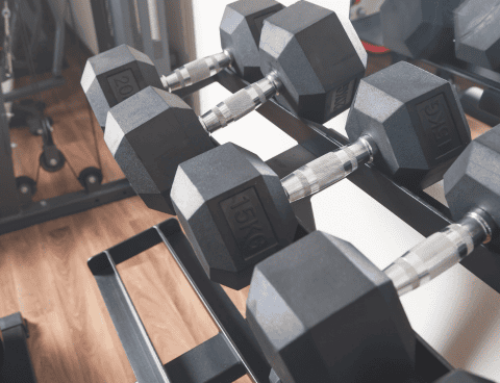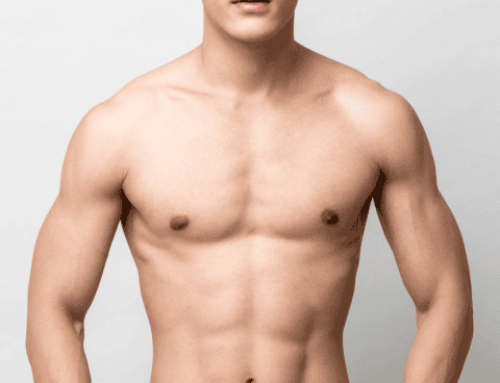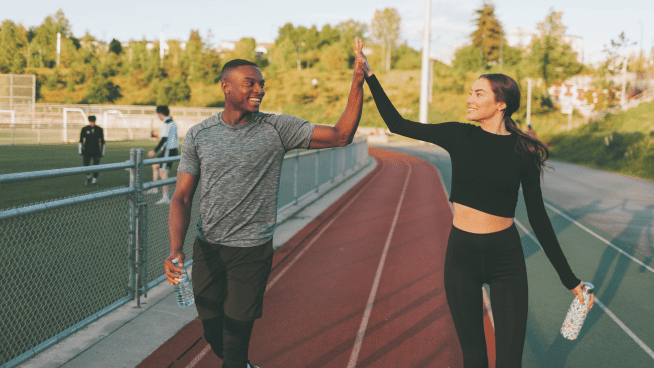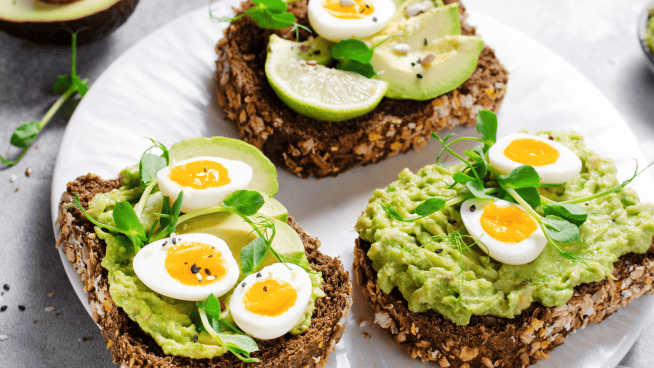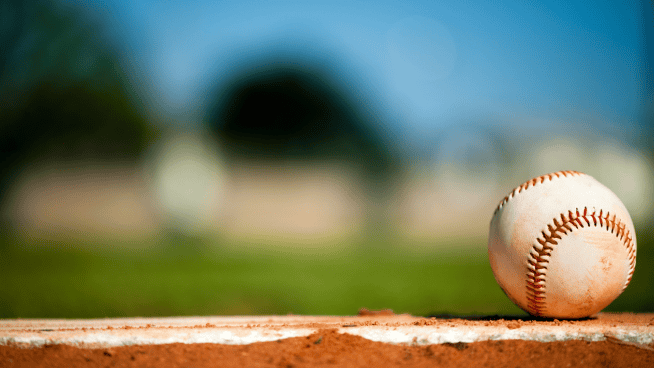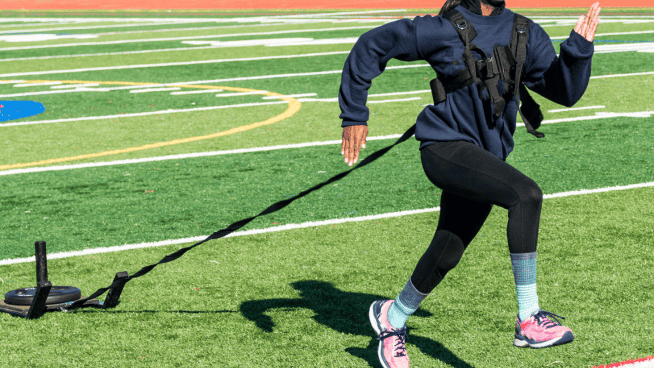Quarterback Guru Ryan Flaherty’s Workout Secrets
No one needs to remind you that as a quarterback you face unique challenges and dangers. You take the most blindside hits. You get the most helmet-to-the-ribs shots. And if you throw an interception, literally every opposing player on the field looks to pepper you. And we haven’t even mentioned the constant wear and tear that throwing the ball puts on your body.
“As a rotational, overhead athlete, you have to take care of your body in some unique ways,” says Ryan Flaherty, senior director of performance at Nike and off-season strength coach to Russell Wilson, Carson Palmer, Marcus Mariota and other top NFL QBs. “You can’t train like everybody else.”
But what Flaherty sees all the time—and what drives him mad—are young quarterbacks training exactly like their linebacker and tight end friends. While your workouts should be similar those of your teammates, certain small (but important) details can make or break your performance. Here are the six things on Flaherty’s must-do list for elite QBs.
1. Do Extra Shoulder Work
Put simply, building healthy shoulders should be at the top of your priority list. They need to be strong and stable to handle powerful throws and big tackles over and over again.
Proper shoulder training means strengthening both large and small muscles. Build the muscles of your upper back, which add support to your shoulders, by doing pulling and rowing exercises such as Pull-Ups and Single-Arm Rows. You also want to strengthen the small muscles that stabilize your shoulder joint, such as the four rotator cuff muscles.
“The small muscles of the shoulder girdle go untrained or unnoticed. Those are the muscles that take the brunt of the force when a hit comes in,” declares Flaherty. “For a quarterback, it’s as important to focus on the small muscles as the big.”
Flaherty recommends a two-pronged approach to bulletproof your shoulders.
Step 1: Warm up your shoulders
Perform Banded External and Internal Rotation exercises before every workout, practice and game.
Banded External Rotation
Attach a lightweight resistance band to a fixed object at the same height as your elbow. Stand with the band to your left and hold the end of the band with your right hand so the band is in front of you. Bend your right elbow to 90 degrees and pin it to your side. Rotate your arm to the right as far as you can without moving your elbow. Pause briefly and slowly return to the starting position
Sets/Reps: 2×10-15 each arm
Banded Internal Rotation
Attach a lightweight resistance band to a fixed object at the same height as your elbow. Stand with the band to your right and hold the end of the band with your right hand. Bend your right elbow to 90 degrees and pin it to your side. Rotate your arm to pull the band across your body without moving your elbow. Pause briefly and slowly return to the starting position.
Sets/Reps: 2×10-15 each arm
Step 2: Strengthen your upper back and shoulders
Perform the I, Y, T, L to strengthen your upper back and shoulders twice per week during upper-body or full-body workouts. Don’t use a plate for the first few times you perform the exercise to build strength.
Plate I, Y, T, L
Lie face down on an incline bench. Hold a lightweight plate in each hand with your thumbs pointing toward the ceiling. With your arms straight and core tight, raise the plates to form the letter I with your upper body, then slowly lower to the starting position. Complete 15 reps and then perform sets forming the letters Y, T and L with your upper body.
Sets/Reps: 1×15 each letter
2. Avoid the Bench Press
Everybody loves the Bench Press. But like we said, “You’re not everybody.” And while this might be a drag to hear, Flaherty recommends that quarterbacks avoid the Bench Press altogether.
Why? Quarterbacks already place a lot of stress on their shoulder from repetitive throwing and contact. It makes no sense to add more stress by forcing the joint to support hundreds of pounds of weight. Also, when you bench, your shoulders and shoulder blades get forced into a fixed position between the barbell and the bench, which can easily damage the joint if you’re not careful.
Flaherty recommends swapping the Bench Press for Push-Up variations, which tend to be easier on your shoulders. Here are his three favorite moves:
Banded 3-Level Push-Ups
Place 6-inch, 12-inch and 18-inch plyo boxes in a row. Place your feet on the lowest box and perform a specified number of Push-Ups with a band under your hands and wrapped around your back. Lift your legs to place them on the middle box, moving your hands in the same direction so you can perform Push-Ups again. Move your feet to the highest box and repeat.
Sets/Reps: 4×5 each height
Plyometric Push-Ups
Assume a push-up position with your back flat and core tight. Lower into a Push-Up and explosively drive your arms into the ground to propel your upper body into the air. Land with your hands back in a push-up position. Bend your elbows and immediately move into the next rep.
Sets/Reps: 4×3
Drop Push-Ups

Set up two 12-inch plyo boxes just outside of each hand in your normal push-up setup. Place your hands on the boxes and assume a push-up position with your back flat and core tight. Drop off the plyo boxes and land on the ground between the boxes with your hands in a push-up position and decelerate your body to the ground. Reset to the starting position.
Sets/Reps: 4×5
3. Avoid Olympic Lifts
Here’s another football training staple that Flaherty recommends QBs should steer clear of. He says, “For a quarterback, Olympic lifts can be detrimental to your health and long-term career.”
To Flaherty, the equation is simple. Are you an Olympian? No. So why do Olympic lifts? Most athletes don’t have the time to perfect the technique needed to safely and correctly execute these complex movements.
“I talk to so many Olympic lifting coaches, and every single one says that it takes two years to teach an Olympic lifter how to do Olympic lifts properly,” Flaherty says. “I watch high school football players in their freshman year doing Power Cleans and Snatches, and it makes my stomach turn.”
The risk simply isn’t worth the reward—especially when other, easier-to-learn exercises are proven to increase strength, power and speed nearly as well.
Flaherty’s go-to explosive power moves for quarterbacks are the Trap Bar Deadlift and Box Squat. Perform one lift during a workout early in the week, and the other toward the end of the week.
Trap Bar Deadlift
Stand with your feet hip-width apart in the center of a trap bar. Bend your hips and knees and reach down to grasp the handles at your sides. Tighten your core, pull your shoulders down and back, and tuck your chin. Extend your hips and knees and drive through your heels to stand up straight. Squeeze your glutes at the top of the movement.
Sets/Reps: 5×3-5
Box Squat
Place a 16-inch box or bench in a squat rack behind where you will be squatting. Position the barbell across your upper back, unrack the bar and step back until the box is about six inches behind you. Stand with your feet shoulder-width apart, pull the bar into your back and tighten your core. Sit your hips back and squat down until your butt touches the box. Keeping your core tight, rock your torso back slightly and then explosively drive your hips forward to stand up out of the Squat.
Sets/Reps: 5×3-5
RELATED: Learn how to properly set up for a Squat.
4. Build Complete Hip Strength
Your hips power almost every football skill from throwing to sprinting. But Flaherty says many young quarterbacks miss a key aspect of hip strength.
“When I travel around the country, I see a lot of hip mobility work but I don’t see a lot of hip strengthening,” Flaherty says. “Without hip strength, hip mobility won’t do you much good.”
Squats and Deadlifts (see above) target the glutes, the most powerful muscle group in the hips. That’s great. But your hips are responsible for more than just extending or straightening. They also need to be able to move and rotate your leg inward and outward. So you need to take your hip training a step further.
First, do your Deadlifts and Squats with a lightweight resistance band above your knees. This activates your glutes to prevent your knees from collapsing inward, which is one of the most common causes of ACL injuries.
Second, perform hip isolation exercises from a standing position, like the Standing Single-Leg Banded Clamshell. These movements teach your femur (upper leg bone) to rotate in your hip joint, allowing your hips to add more power to your throws while also protecting your knee.
Standing Banded Clamshell
Place a mini-band around your legs, just above your knees. Stand with your feet shoulder-width apart and lower into a Quarter Squat. Rotate your right leg to the outside as far as you can. Pause and return to the starting position.
Sets/Reps: 2×10 each leg
5. Make Single-Leg Training a Priority
Other than the Trap Bar Deadlift and Box Squat, Flaherty says every lower-body move you do should be done on one leg.
“The focus for a high school quarterback has to be single-leg exercises, because the majority of the forces they withstand aren’t straight ahead with their shoulders square and feet on the ground,” Flaherty says. “Almost every single time, it’s with one foot on the ground.”
Single-leg exercises build the strength and stability you need to drive off the ground and launch powerful passes or make explosive changes of direction. These moves also help you withstand contact to your legs without getting injured.
Flaherty points to Russell Wilson’s knee injury in Week 3 of the 2016 NFL season as an example. The collision was violent, but Wilson suffered only a minor MCL sprain because he had the single-leg strength to absorb the hit and avoid a more severe injury.
Along with the Seahawks’ training staff, Flaherty has Wilson do single-leg work three times per week. The coach’s favorite exercises include Dumbbell Bulgarian Split-Squats, Barbell Reverse Lunges and Single-Leg Bounding.
Dumbbell Bulgarian Split-Squats
Stand in a lunge position with your back foot on a bench or a box and hold dumbbells in each hand. Keeping your chest up and core tight, lower into a lunge position until your thigh is parallel to the ground. Drive up to the starting position by extending your hip and knee.
Sets/Reps: 4×5 each leg
Barbell Reverse Lunges
Stand with your feet hip-width apart holding a barbell across the front of your shoulders in the rack position used in the Front Squat. Take an exaggerated step back with your right leg and bend your left knee to lower into a Lunge until your left thigh is parallel to the ground. Drive through your left heel to stand up and return to the starting position.
Sets/Reps: 4×5 each leg
Single-Leg Bounding
Stand on one leg with your knee and hip slightly bent. Leap forward off your leg as far as possible by fully extending your hip, knee and ankle. Swing your arms to generate forward momentum. Land softly on the same leg and immediately perform the next rep, spending as little time on the ground as possible.
Sets/Reps: 3×6 each leg
6. Improve Your First-Step Quickness
You don’t need to be the fastest guy on the field, but you do want the evasive speed and quickness to move around the pocket and avoid pass rushers. Watch Tom Brady. The guy isn’t fast, but he can maneuver in the backfield and create time.
Practice sprinting from the quarterback setup
Flaherty has quarterbacks almost always perform speed, agility, footwork and pocket drills out of the quarterback setup with their body perpendicular to the field like they are when they drop back to pass.
From this position, take your first step with your rear foot. If you’re right-handed, this would be your right leg.
“I see a lot of guys doing reaction drills and step with their front foot first,” Flaherty explains. “This is the worst thing you can do as a quarterback, because you always want to plant your back foot so your power foot is on the ground if you need to throw the ball.”
Additionally, stepping with your “power foot” gives you a better first step so you can move in the pocket more quickly and set up for your pass that much faster.
Lean forward when accelerating
Flaherty says that when most quarterbacks take off into a sprint, they stand almost completely upright. That stance all but guarantees that they’ll move like a sloth. Instead, on your first three or four strides, move with an abbreviated version of the drive phase that you learn when you practice the 40-Yard Dash.
“Whether you’re scrambling forward, left or to the right, you still need to have some sort of drive phase,” he adds.
To achieve this position, lean forward at a 45-degree angle and drive your legs backward into the ground to propel your body forward. Your foot should strike the ground directly under your hips with your shin angled forward in the same direction as your torso.
Flaherty recommends performing Push-Up Starts to learn and reinforce this technique.
Push-Up Starts
Lie with your stomach on the ground and hands flat on the ground next to your chest as if performing a Push-Up. Explosively push yourself up and immediately sprint forward by driving your feet backward into the ground. Maintain a forward lean; do not stand straight up.
Sets/Reps: 4×15 yards
Read More:
- Marcus Mariota’s Speed and Strength Workout
- Quarterback Throwing Drills With Drew Brees
- How to Improve Your 5-Step Drop
Get More Off-Season Football Workouts
RECOMMENDED FOR YOU
MOST POPULAR
Quarterback Guru Ryan Flaherty’s Workout Secrets
No one needs to remind you that as a quarterback you face unique challenges and dangers. You take the most blindside hits. You get the most helmet-to-the-ribs shots. And if you throw an interception, literally every opposing player on the field looks to pepper you. And we haven’t even mentioned the constant wear and tear that throwing the ball puts on your body.
“As a rotational, overhead athlete, you have to take care of your body in some unique ways,” says Ryan Flaherty, senior director of performance at Nike and off-season strength coach to Russell Wilson, Carson Palmer, Marcus Mariota and other top NFL QBs. “You can’t train like everybody else.”
But what Flaherty sees all the time—and what drives him mad—are young quarterbacks training exactly like their linebacker and tight end friends. While your workouts should be similar those of your teammates, certain small (but important) details can make or break your performance. Here are the six things on Flaherty’s must-do list for elite QBs.
1. Do Extra Shoulder Work
Put simply, building healthy shoulders should be at the top of your priority list. They need to be strong and stable to handle powerful throws and big tackles over and over again.
Proper shoulder training means strengthening both large and small muscles. Build the muscles of your upper back, which add support to your shoulders, by doing pulling and rowing exercises such as Pull-Ups and Single-Arm Rows. You also want to strengthen the small muscles that stabilize your shoulder joint, such as the four rotator cuff muscles.
“The small muscles of the shoulder girdle go untrained or unnoticed. Those are the muscles that take the brunt of the force when a hit comes in,” declares Flaherty. “For a quarterback, it’s as important to focus on the small muscles as the big.”
Flaherty recommends a two-pronged approach to bulletproof your shoulders.
Step 1: Warm up your shoulders
Perform Banded External and Internal Rotation exercises before every workout, practice and game.
Banded External Rotation
Attach a lightweight resistance band to a fixed object at the same height as your elbow. Stand with the band to your left and hold the end of the band with your right hand so the band is in front of you. Bend your right elbow to 90 degrees and pin it to your side. Rotate your arm to the right as far as you can without moving your elbow. Pause briefly and slowly return to the starting position
Sets/Reps: 2×10-15 each arm
Banded Internal Rotation
Attach a lightweight resistance band to a fixed object at the same height as your elbow. Stand with the band to your right and hold the end of the band with your right hand. Bend your right elbow to 90 degrees and pin it to your side. Rotate your arm to pull the band across your body without moving your elbow. Pause briefly and slowly return to the starting position.
Sets/Reps: 2×10-15 each arm
Step 2: Strengthen your upper back and shoulders
Perform the I, Y, T, L to strengthen your upper back and shoulders twice per week during upper-body or full-body workouts. Don’t use a plate for the first few times you perform the exercise to build strength.
Plate I, Y, T, L
Lie face down on an incline bench. Hold a lightweight plate in each hand with your thumbs pointing toward the ceiling. With your arms straight and core tight, raise the plates to form the letter I with your upper body, then slowly lower to the starting position. Complete 15 reps and then perform sets forming the letters Y, T and L with your upper body.
Sets/Reps: 1×15 each letter
2. Avoid the Bench Press
Everybody loves the Bench Press. But like we said, “You’re not everybody.” And while this might be a drag to hear, Flaherty recommends that quarterbacks avoid the Bench Press altogether.
Why? Quarterbacks already place a lot of stress on their shoulder from repetitive throwing and contact. It makes no sense to add more stress by forcing the joint to support hundreds of pounds of weight. Also, when you bench, your shoulders and shoulder blades get forced into a fixed position between the barbell and the bench, which can easily damage the joint if you’re not careful.
Flaherty recommends swapping the Bench Press for Push-Up variations, which tend to be easier on your shoulders. Here are his three favorite moves:
Banded 3-Level Push-Ups
Place 6-inch, 12-inch and 18-inch plyo boxes in a row. Place your feet on the lowest box and perform a specified number of Push-Ups with a band under your hands and wrapped around your back. Lift your legs to place them on the middle box, moving your hands in the same direction so you can perform Push-Ups again. Move your feet to the highest box and repeat.
Sets/Reps: 4×5 each height
Plyometric Push-Ups
Assume a push-up position with your back flat and core tight. Lower into a Push-Up and explosively drive your arms into the ground to propel your upper body into the air. Land with your hands back in a push-up position. Bend your elbows and immediately move into the next rep.
Sets/Reps: 4×3
Drop Push-Ups

Set up two 12-inch plyo boxes just outside of each hand in your normal push-up setup. Place your hands on the boxes and assume a push-up position with your back flat and core tight. Drop off the plyo boxes and land on the ground between the boxes with your hands in a push-up position and decelerate your body to the ground. Reset to the starting position.
Sets/Reps: 4×5
3. Avoid Olympic Lifts
Here’s another football training staple that Flaherty recommends QBs should steer clear of. He says, “For a quarterback, Olympic lifts can be detrimental to your health and long-term career.”
To Flaherty, the equation is simple. Are you an Olympian? No. So why do Olympic lifts? Most athletes don’t have the time to perfect the technique needed to safely and correctly execute these complex movements.
“I talk to so many Olympic lifting coaches, and every single one says that it takes two years to teach an Olympic lifter how to do Olympic lifts properly,” Flaherty says. “I watch high school football players in their freshman year doing Power Cleans and Snatches, and it makes my stomach turn.”
The risk simply isn’t worth the reward—especially when other, easier-to-learn exercises are proven to increase strength, power and speed nearly as well.
Flaherty’s go-to explosive power moves for quarterbacks are the Trap Bar Deadlift and Box Squat. Perform one lift during a workout early in the week, and the other toward the end of the week.
Trap Bar Deadlift
Stand with your feet hip-width apart in the center of a trap bar. Bend your hips and knees and reach down to grasp the handles at your sides. Tighten your core, pull your shoulders down and back, and tuck your chin. Extend your hips and knees and drive through your heels to stand up straight. Squeeze your glutes at the top of the movement.
Sets/Reps: 5×3-5
Box Squat
Place a 16-inch box or bench in a squat rack behind where you will be squatting. Position the barbell across your upper back, unrack the bar and step back until the box is about six inches behind you. Stand with your feet shoulder-width apart, pull the bar into your back and tighten your core. Sit your hips back and squat down until your butt touches the box. Keeping your core tight, rock your torso back slightly and then explosively drive your hips forward to stand up out of the Squat.
Sets/Reps: 5×3-5
RELATED: Learn how to properly set up for a Squat.
4. Build Complete Hip Strength
Your hips power almost every football skill from throwing to sprinting. But Flaherty says many young quarterbacks miss a key aspect of hip strength.
“When I travel around the country, I see a lot of hip mobility work but I don’t see a lot of hip strengthening,” Flaherty says. “Without hip strength, hip mobility won’t do you much good.”
Squats and Deadlifts (see above) target the glutes, the most powerful muscle group in the hips. That’s great. But your hips are responsible for more than just extending or straightening. They also need to be able to move and rotate your leg inward and outward. So you need to take your hip training a step further.
First, do your Deadlifts and Squats with a lightweight resistance band above your knees. This activates your glutes to prevent your knees from collapsing inward, which is one of the most common causes of ACL injuries.
Second, perform hip isolation exercises from a standing position, like the Standing Single-Leg Banded Clamshell. These movements teach your femur (upper leg bone) to rotate in your hip joint, allowing your hips to add more power to your throws while also protecting your knee.
Standing Banded Clamshell
Place a mini-band around your legs, just above your knees. Stand with your feet shoulder-width apart and lower into a Quarter Squat. Rotate your right leg to the outside as far as you can. Pause and return to the starting position.
Sets/Reps: 2×10 each leg
5. Make Single-Leg Training a Priority
Other than the Trap Bar Deadlift and Box Squat, Flaherty says every lower-body move you do should be done on one leg.
“The focus for a high school quarterback has to be single-leg exercises, because the majority of the forces they withstand aren’t straight ahead with their shoulders square and feet on the ground,” Flaherty says. “Almost every single time, it’s with one foot on the ground.”
Single-leg exercises build the strength and stability you need to drive off the ground and launch powerful passes or make explosive changes of direction. These moves also help you withstand contact to your legs without getting injured.
Flaherty points to Russell Wilson’s knee injury in Week 3 of the 2016 NFL season as an example. The collision was violent, but Wilson suffered only a minor MCL sprain because he had the single-leg strength to absorb the hit and avoid a more severe injury.
Along with the Seahawks’ training staff, Flaherty has Wilson do single-leg work three times per week. The coach’s favorite exercises include Dumbbell Bulgarian Split-Squats, Barbell Reverse Lunges and Single-Leg Bounding.
Dumbbell Bulgarian Split-Squats
Stand in a lunge position with your back foot on a bench or a box and hold dumbbells in each hand. Keeping your chest up and core tight, lower into a lunge position until your thigh is parallel to the ground. Drive up to the starting position by extending your hip and knee.
Sets/Reps: 4×5 each leg
Barbell Reverse Lunges
Stand with your feet hip-width apart holding a barbell across the front of your shoulders in the rack position used in the Front Squat. Take an exaggerated step back with your right leg and bend your left knee to lower into a Lunge until your left thigh is parallel to the ground. Drive through your left heel to stand up and return to the starting position.
Sets/Reps: 4×5 each leg
Single-Leg Bounding
Stand on one leg with your knee and hip slightly bent. Leap forward off your leg as far as possible by fully extending your hip, knee and ankle. Swing your arms to generate forward momentum. Land softly on the same leg and immediately perform the next rep, spending as little time on the ground as possible.
Sets/Reps: 3×6 each leg
6. Improve Your First-Step Quickness
You don’t need to be the fastest guy on the field, but you do want the evasive speed and quickness to move around the pocket and avoid pass rushers. Watch Tom Brady. The guy isn’t fast, but he can maneuver in the backfield and create time.
Practice sprinting from the quarterback setup
Flaherty has quarterbacks almost always perform speed, agility, footwork and pocket drills out of the quarterback setup with their body perpendicular to the field like they are when they drop back to pass.
From this position, take your first step with your rear foot. If you’re right-handed, this would be your right leg.
“I see a lot of guys doing reaction drills and step with their front foot first,” Flaherty explains. “This is the worst thing you can do as a quarterback, because you always want to plant your back foot so your power foot is on the ground if you need to throw the ball.”
Additionally, stepping with your “power foot” gives you a better first step so you can move in the pocket more quickly and set up for your pass that much faster.
Lean forward when accelerating
Flaherty says that when most quarterbacks take off into a sprint, they stand almost completely upright. That stance all but guarantees that they’ll move like a sloth. Instead, on your first three or four strides, move with an abbreviated version of the drive phase that you learn when you practice the 40-Yard Dash.
“Whether you’re scrambling forward, left or to the right, you still need to have some sort of drive phase,” he adds.
To achieve this position, lean forward at a 45-degree angle and drive your legs backward into the ground to propel your body forward. Your foot should strike the ground directly under your hips with your shin angled forward in the same direction as your torso.
Flaherty recommends performing Push-Up Starts to learn and reinforce this technique.
Push-Up Starts
Lie with your stomach on the ground and hands flat on the ground next to your chest as if performing a Push-Up. Explosively push yourself up and immediately sprint forward by driving your feet backward into the ground. Maintain a forward lean; do not stand straight up.
Sets/Reps: 4×15 yards
Read More:
- Marcus Mariota’s Speed and Strength Workout
- Quarterback Throwing Drills With Drew Brees
- How to Improve Your 5-Step Drop


